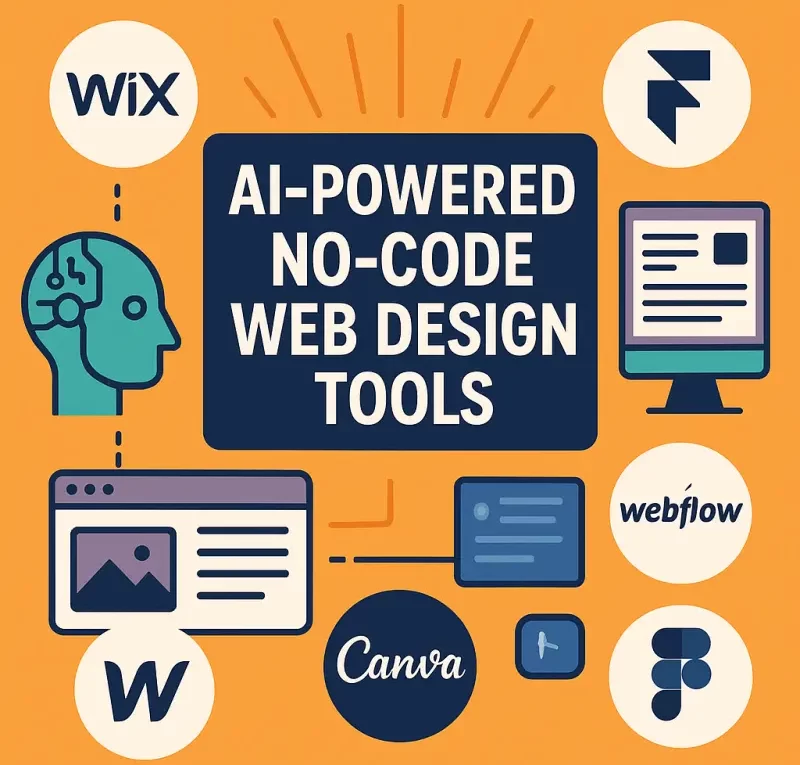The Rise of AI-Powered Web Design Tools
The Rise of AI-Powered Web Design Tools: How No-Code Platforms Are Changing the Game for Beginners
The world of web design is evolving rapidly, and artificial intelligence (AI) is playing a significant role in making it more accessible to everyone. No longer do aspiring website creators need to learn complex coding languages to build a stunning online presence. Thanks to AI-powered no-code platforms, beginners can now design professional websites with ease. Let’s explore how these tools are revolutionizing web design and what the future holds.
What Are No-Code Platforms and Why Are They Gaining Popularity?
No-code platforms allow users to create websites without writing a single line of code. Instead of relying on traditional programming, these platforms use AI-driven drag-and-drop interfaces, automation, and templates to simplify the design process. This shift has led to an explosion in their popularity, particularly among small business owners, freelancers, and startups looking to establish a web presence without hiring a developer.
The key reasons behind their rise include:
- Ease of Use – No prior coding knowledge required.
- Faster Development – Websites can be built in hours instead of weeks.
- Cost-Effective – Reduces the need for expensive developers and designers.
- AI Assistance – Intelligent tools that help with layout, content, and optimization.
Examples of AI-Powered No-Code Web Design Tools
Several no-code web design tools are making waves in the industry, each with its unique AI-driven features:
- Wix ADI (Artificial Design Intelligence): Wix ADI asks users a few questions about their website needs and automatically generates a customized design with optimized layouts, color schemes, and content suggestions.
- Framer: Framer combines AI and no-code design principles to create highly responsive and interactive websites without the complexity of coding.
- Webflow: Webflow empowers users with a powerful visual editor, AI-driven design suggestions, and the ability to export code if needed.
- Canva: While primarily known for graphic design, Canva now offers website-building features that allow users to create simple, visually appealing sites without coding.
- Figma: A powerful UI/UX design tool, Figma enables collaborative web design, allowing designers to create and prototype sites with ease, even integrating AI-driven elements for efficiency.
How These Tools Help Beginners Create Professional Websites
AI-powered no-code platforms are transforming the way beginners approach web design. Some of the key benefits include:
- Automated Design Assistance: AI suggests design elements, font pairings, and color schemes based on industry best practices.
- SEO and Performance Optimization: Many platforms include built-in SEO recommendations and performance enhancements.
- Pre-Made Templates and Components: Users can start with professionally designed templates and customize them without technical skills.
- AI-Generated Content: Some platforms even offer AI-driven text and image recommendations to speed up the content creation process.
The Pros and Cons of Relying on AI for Web Design
While AI-powered no-code tools have made web design easier, they do come with advantages and limitations.
Pros:
- Saves time and effort.
- Lowers the barrier to entry for beginners.
- Enables quick iterations and testing.
- AI insights help optimize UX and accessibility.
Cons:
- Limited customization compared to custom-coded websites.
- Some AI-generated designs can feel generic.
- Potential SEO and scalability limitations.
- Dependency on third-party platforms and templates.
The Future of AI in Web Design
As AI technology continues to evolve, the future of web design is set to become even more innovative. Here’s what we can expect:
- More Advanced AI Personalization: AI will better understand user preferences and create hyper-personalized designs.
- Improved Automation and Integration: AI-driven platforms will seamlessly integrate with marketing tools, e-commerce solutions, and customer analytics.
- Voice and Chat-Based Website Building: Users might soon create websites using voice commands or conversational AI chatbots.
- Greater AI Creativity: AI may start suggesting not just layouts but also unique design ideas tailored to specific brands.
Final Thoughts
AI-powered no-code web design tools are revolutionizing the industry, making it easier than ever for beginners to create professional and functional websites. While these platforms offer convenience and efficiency, understanding their strengths and limitations is crucial. As AI continues to advance, the possibilities for web design will only expand, bridging the gap between creativity and technology.
Whether you’re a beginner looking to create your first website or a business seeking a quick and effective online presence, AI-powered tools offer an exciting and accessible solution. The future of web design is here, and it’s powered by AI.
AI-Powered Design Systems: Revolutionizing Web Development in 2025

